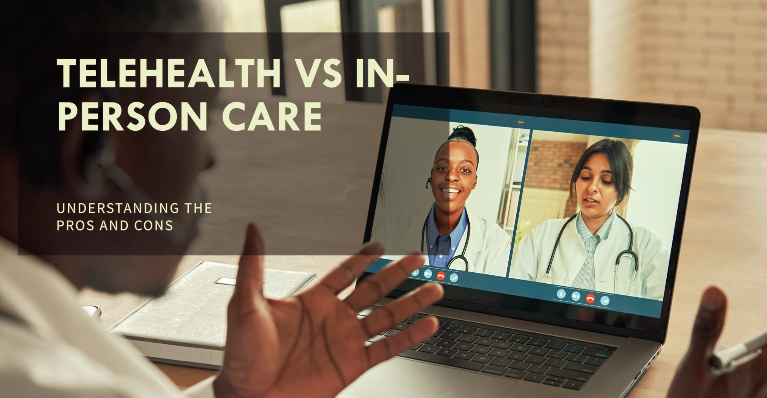
The rapidly evolving healthcare sector attests to accelerated medical and technological advancements. Within this sphere of progression, two modalities of patient care provision stand significant: telehealth and in-person care. As the world is inclining towards digitalization, the healthcare paradigm has been greatly impacted. However, understanding the distinctive features of telehealth and in-person care equips us with the competence to optimize patient engagement effectively.
Table of content
- Distance vs. Proximity: The Core Factor in Patient Care
- Patient Engagement and Feedback Mechanism
- Telehealth vs. In-Person: Quality and Continuity of Care
- Accessibility and Convenience: Shaping Patient Experience
- Trust and Building Doctor-Patient Relationships
- Cost-effectiveness: A Crucial Determiner
- Limitations and Advantages: A Comparative Overview
Distance vs. Proximity: The Core Factor in Patient Care
The evident distinction between telehealth and in-person care hinges on proximity: while telehealth operates remotely, in-person care entails face-to-face encounters. Telehealth embodies the power of digital platforms to provide healthcare assistance to patients irrespective of geographical barriers, enabling broad-spectrum access to medical help. It fundamentally increases patient engagement by enabling patients to access healthcare services from the comfort of their homes.
In contrast, in-person care necessitates the physical presence of the patient and the healthcare provider in the same place. Though this may seem restrictive compared to telehealth, it allows immediate responses to emergencies and facilitates procedures requiring direct physical intervention or tests requiring specialized equipment.
Patient Engagement and Feedback Mechanism
In the context of patient engagement, telehealth and in-person care follow divergent pathways. Telehealth services substantially increase patient engagement, enabling patients to readily schedule appointments, access their medical records, and review their progress through a digital portal. In addition, it offers the flexibility to provide immediate patient feedback and evaluate patient surveys remotely, which in turn helps enhance care delivery.
On the other hand, in-person care provides an interactive environment. It allows the healthcare provider to gauge nuances of patient communication, which may be vital for diagnosis and treatment design. Patient engagement in in-person encounters possesses a personal touch, and the immediate patient feedback received proves beneficial in refining care provision. Nonetheless, deploying patient surveys is challenging here, as it demands physical distribution and collection of forms.
Telehealth vs. In-Person: Quality and Continuity of Care
When aligned with quality and continuity of care, telehealth and in-person approaches possess unique advantages. With technological capacities, Telehealth facilitates access to multiple specialists, genetic counselors, health coaches, and proffers coordinated care. However, technology glitches and limited physical examinations might impede the quality of care.
On the other hand, in-person services often provide detailed and comprehensive examinations. Though it fails to beat telehealth’s convenience, it secures an irrefutable position in critical and immediate healthcare delivery. However, patients may struggle to manage continuous in-person visits due to logistic or health constraints.
Accessibility and Convenience: Shaping Patient Experience
A significant contrast between telehealth and in-person care revolves around accessibility and convenience, significant pillars in shaping patient experiences. In the realm of telehealth, vast geographical boundaries become inconsequential. Patients living in remote areas or those with mobility issues can easily access healthcare services, increasing patient engagement on a global scale.
In contrast, in-person care largely depends on a patient’s proximity to a healthcare facility. While it might complicate accessibility for some, for others, it presents the advantage of direct physical interaction and immediacy of care, offering a traditional and familiar approach to healthcare.
Trust and Building Doctor-Patient Relationships
In the matrix of healthcare, trust and relationship building hold vital importance. Telehealth, though efficient, may lack the human touch. Physical cues from patients, like their discomfort or unease, can be easily missed in a virtual encounter, potentially creating a sense of disconnect.
Conversely, in the realm of in-person care, there is a unique human-to-human connection. Face-to-face consultations can comfort many patients and lead to stronger doctor-patient relationships. It’s an opportunity for healthcare providers to comfort their patients through direct interaction, which can positively affect patient feedback and reviews.
Cost-effectiveness: A Crucial Determiner
Cost-effectiveness is another crucial parameter that distinguishes telehealth from in-person care. Telehealth is a cost-effective alternative by eliminating transportation costs and minimizing the loss of work hours for medical consultations. It also reduces readmission rates and hospital visits, leading to substantial healthcare savings.
On the other hand, in-person care, depending on the procedure or treatment, can be more expensive due to infrastructural and operational expenses. However, it’s crucial to consider that certain conditions may require in-person care despite the cost due to the need for intricate examinations or immediate medical intervention.
Limitations and Advantages: A Comparative Overview
Every modality has unique limitations and advantages, which can determine its utility based on individual instances. Telehealth, while offering a plethora of conveniences, nudges upon challenges like technology literacy for patients, lack of physical presence, and potential privacy concerns.
Despite providing comprehensive and detailed examinations, in-person care struggles with limited access, especially in geographically challenging areas, scheduling barriers, and risk of infections during hospital visits.
Understanding and addressing the legislative, operational, and practical differences between telehealth and in-person care is imperative for providing integrated, individualized patient care. As healthcare systems continue to evolve, these modalities will likely learn from each other and adapt, ever improving the quality and reach of care.
Conclusion
While telehealth and in-person care offer unique benefits, the deciding factor often gravitates toward the nature of medical attention needed, patient preference, and accessibility. As healthcare providers, understanding the crucial differences between these modalities and striking an appropriate balance when integrating them into our practices can enhance patient engagement and satisfaction. Telehealth and in-person care services are pivotal to holistic and comprehensive patient care.




